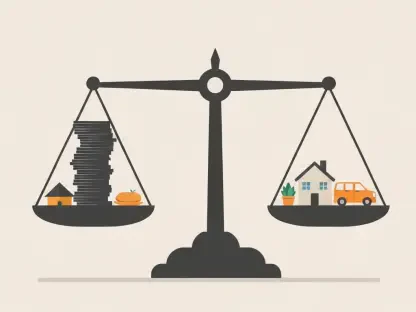In an era where economic pressures are mounting, nonprofits are grappling with a perfect storm of rising inflation, escalating operational costs, and shrinking funding sources across critical sectors like healthcare, housing, food, and education. These organizations, often the lifeline for vulnerable communities, face a daunting reality where the cost of delivering essential services continues to climb while donations and government support dwindle. The financial vise tightens as families prioritize personal essentials over charitable giving, and post-pandemic emergency funds dry up despite persistent high demand for services. This challenging landscape demands more than just perseverance; it requires a fundamental shift in how nonprofits operate and sustain themselves. To navigate these turbulent times, a strategic blend of financial discipline and innovative thinking is essential. Nonprofits must move beyond traditional reliance on familiar funding streams and outdated operational models. Instead, embracing tighter financial oversight, enhancing employee retention, modernizing operations through technology, and diversifying revenue sources can pave the way for resilience. This article explores actionable strategies to help nonprofits not only survive but thrive amidst economic uncertainty, ensuring they continue to fulfill their vital missions.
1. Understanding the Economic Landscape
The economic environment has become increasingly hostile for nonprofits, with inflation driving up expenses for rent, utilities, supplies, and staff salaries to match the soaring cost of living. These escalating costs strain budgets that are already stretched thin, making it harder for organizations to maintain their level of service. Many nonprofits are forced to confront the harsh reality of doing more with less, as the demand for their programs remains high. Reports indicate a significant decline in charitable giving, with many households redirecting funds to cover basic needs. This shift in donor behavior exacerbates the financial challenges, leaving nonprofits scrambling to cover basic operational costs, let alone invest in growth or innovation.
Beyond inflation, the post-pandemic recovery has brought additional hurdles, as government resources that once provided emergency relief have largely been reallocated or discontinued. During the height of the crisis, federal and state funding helped cover salaries and program expenses, but those safety nets are now gone. Meanwhile, the need for services has not diminished; in fact, it has surged in many communities. Nonprofits find themselves in a precarious position, dipping into reserves or delaying critical hires to stay afloat. While service cuts are sometimes considered, they are not sustainable solutions given the growing needs of the populations served. The gap between available resources and rising demands underscores the urgency for strategic adaptation in this unforgiving economic climate.
2. Leveraging Technology for Cost Savings and Efficiency
Technology offers a powerful avenue for nonprofits to reduce costs and enhance efficiency, yet many hesitate due to initial investment requirements and a lack of internal expertise. Unlike the private sector, which has swiftly adopted tools like artificial intelligence and automation, nonprofits often lag behind, hindered by budget constraints or uncertainty about how digital solutions align with their missions. However, the potential benefits of tech adoption are substantial, from streamlining administrative tasks to expanding service reach. Starting small and focusing on high-impact areas can make the transition manageable, while seeking grants or corporate partnerships can offset upfront costs. Embracing digital tools positions nonprofits to better weather financial uncertainties with improved operational agility.
Practical steps for modernization include automating back-office operations with tools for bookkeeping, payroll, and compliance, which can significantly cut administrative expenses. Many platforms offer discounts tailored for nonprofits, freeing up staff time for mission-critical work. Additionally, AI-powered solutions can transform fundraising by analyzing donor trends and personalizing outreach, while grant writing software streamlines applications to boost funding success. Digital platforms like customer relationship management systems enhance donor engagement by tracking giving histories and optimizing communication strategies. Virtual tools, such as telehealth for healthcare nonprofits or online learning for education programs, also enable broader service delivery at reduced overhead, demonstrating that strategic tech investments can yield long-term savings and impact.
3. Implementing Smart Financial Strategies for Stability
Given persistent funding gaps, nonprofits must adopt proactive financial management to ensure long-term sustainability. This begins with meticulous cash flow monitoring through detailed forecasts to anticipate shortfalls and prepare for lean periods, minimizing the need for costly borrowing. Building reserve funds equivalent to 3-6 months of operating expenses provides a critical buffer during economic downturns, achievable through targeted fundraising or reallocating surpluses. Assessing program viability is equally important; organizations should evaluate which initiatives are financially sustainable and consider restructuring or partnering with others to maintain overall health. These strategies collectively form a robust framework for navigating economic uncertainty.
Diversifying revenue streams beyond traditional grants and donations is another vital tactic, incorporating corporate sponsorships, foundation support, membership models, and fee-for-service offerings. Fundraising efforts should focus on targeted campaigns, recurring gifts, and digital platforms, using compelling storytelling to attract support. Strengthening donor relationships through personalized engagement and recognition events fosters loyalty, while transparent financial reporting builds trust with stakeholders. Cost-saving measures, such as outsourcing non-core functions or negotiating better vendor terms, further enhance efficiency. Regular strategic planning, staying informed on regulatory changes, and adapting to external trends ensure nonprofits remain aligned with their missions while preparing for unforeseen challenges.
4. Retaining Talent in a Competitive Labor Market
Attracting and retaining mission-driven employees poses a significant challenge for nonprofits, especially in a tight labor market where turnover costs can exceed 30% of additional expenses. High staff turnover disrupts service delivery and strains budgets, making retention a priority. Creating a positive workplace culture through clear communication and professional development opportunities helps employees feel valued and committed to the organization’s goals. Nonprofits must focus on building an environment where staff are motivated to stay, even when financial compensation cannot compete with private sector offers, by emphasizing the intrinsic rewards of their work and fostering a sense of purpose.
While matching salaries may not always be feasible, offering small-scale perks can make a difference, such as flexible work arrangements, wellness programs, or development stipends. Addressing burnout is critical, as nonprofit staff often face heavy workloads and emotional demands; mental health resources and team-building activities can support work-life balance. Providing clear career growth pathways through training and mentorship ensures employees see a future within the organization, reducing the likelihood of seeking higher-paying roles elsewhere. By investing in employee well-being and development, nonprofits can lower turnover costs, strengthen their workforce, and maintain the quality of services delivered to communities in need.
5. Assessing Risks for Operational Resilience
In an unpredictable economic climate, nonprofits must prioritize risk assessment to identify and mitigate potential threats to their operations. Conducting thorough evaluations of internal and external risks—such as funding shortfalls, economic downturns, or regulatory shifts—helps organizations prepare for challenges. Engaging board members, staff, and stakeholders in this process ensures a comprehensive understanding of vulnerabilities. Prioritizing risks based on likelihood and impact allows for targeted mitigation strategies, while regular reassessment keeps plans relevant. Integrating risk management into strategic planning fosters a proactive culture, equipping nonprofits to handle disruptions effectively.
To address specific risks, diversifying funding sources can counteract declines in grants by building relationships with corporate sponsors and community foundations. Operational risks, like staff turnover or technological failures, require investments in training, IT upgrades, and cross-training to ensure continuity. Scenario planning, modeling various economic and operational futures, aids in stress-testing strategies and developing contingency plans. By continuously monitoring external conditions and adapting to changes, nonprofits can maintain flexibility and resilience. These steps collectively safeguard operations, minimize losses, and position organizations to seize opportunities, ensuring they remain focused on their missions despite external pressures.
6. Embracing Scenario Planning for Future Preparedness
Scenario planning serves as a strategic tool for nonprofits to navigate uncertainty by mapping out potential future environments and crafting flexible responses. This process involves exploring diverse scenarios based on economic conditions, political shifts, donor behavior, and regulatory changes, enabling organizations to anticipate challenges and opportunities. Identifying vulnerabilities in current strategies through this analysis helps pinpoint areas for improvement. Encouraging adaptability, scenario planning transforms uncertainties into chances for innovation rather than threats, fostering a mindset of agility among leadership and staff in an ever-changing landscape.
Engaging stakeholders in scenario planning ensures varied perspectives shape the strategic direction, enhancing decision-making. By preparing for external shifts, such as funding declines or increased service demand, nonprofits can proactively diversify revenue or adjust program priorities. This forward-thinking approach builds responsiveness, allowing organizations to develop contingency plans and react swiftly to emerging issues. The process not only strengthens operational resilience but also empowers nonprofits to view change as a catalyst for growth. Investing in this strategic exercise equips organizations to handle unpredictability with confidence, ensuring they remain mission-focused regardless of external conditions.
7. Engaging the Board of Directors Effectively
During economic challenges, engaging a nonprofit’s board of directors is crucial for maintaining strategic focus and organizational health. Maintaining transparency through regular updates on financial status, fundraising obstacles, and program outcomes enables informed decision-making. Reaffirming the mission and adjusting strategic plans to align with economic realities keep the board aligned on priorities. Utilizing scenario planning helps anticipate potential hurdles, allowing the board to act proactively. These efforts ensure that board members remain committed and equipped to guide the organization through turbulent times with clarity and purpose.
Encouraging board involvement in fundraising by leveraging personal networks for donor outreach and events can significantly boost resources. Providing training for less-experienced members builds confidence in these efforts. Maximizing board talent in areas like finance or marketing addresses specific challenges, while advocacy for grants or policy changes strengthens external support. Financial oversight, in collaboration with finance committees, ensures cash flow monitoring and sustainable cost reductions. Recognizing board contributions and celebrating small wins sustains morale, fostering a sense of camaraderie. These strategies collectively empower boards to be active, effective partners in navigating economic uncertainty and advancing the mission.
8. Highlighting the Critical Role of Leadership
Strong leadership stands as a cornerstone for nonprofits facing unprecedented financial and operational challenges. Executives and board members must take an active role in shaping financial strategies, driving operational efficiency, and prioritizing talent retention. Their ability to make informed, decisive choices ensures organizations adapt to changing circumstances without losing sight of core objectives. Leadership must champion innovation, guiding teams through uncertainty with a clear vision. By fostering collaboration and accountability, leaders can instill confidence across the organization, positioning it to overcome obstacles and sustain impact.
The path forward hinges on a commitment to adaptability and strategic foresight. Leaders must inspire a culture of resilience, encouraging the adoption of technology and diversified funding approaches to bolster stability. Their role in engaging stakeholders and aligning efforts with the mission cannot be overstated. As economic pressures persist, those at the helm must balance immediate needs with long-term goals, ensuring resources are allocated effectively. Strong leadership not only navigates current challenges but also builds a foundation for future success, enabling nonprofits to continue serving communities with unwavering dedication and purpose.
9. Building a Resilient Future for Nonprofits
Reflecting on the strategies discussed, it becomes evident that nonprofits must tighten financial management, embrace technological advancements, prioritize talent retention, diversify funding sources, and engage strong leadership to weather economic storms. These approaches provide a lifeline, allowing organizations to maintain their missions despite daunting challenges. By focusing on cash flow oversight, building reserves, and adopting digital tools, many nonprofits stabilize their operations in tough times. Transparent communication with donors and stakeholders further solidifies trust, ensuring sustained support even as giving patterns shift.
Looking ahead, the next steps involve a steadfast commitment to adaptability and proactive planning. Nonprofits need to continue refining scenario planning and risk assessment processes to anticipate future disruptions. Investing in employee well-being and board engagement remains critical for maintaining organizational strength. Exploring innovative revenue models and deepening community partnerships offer additional avenues for growth. By staying agile and mission-driven, nonprofits can transform economic challenges into opportunities for reinvention, ensuring they deliver lasting impact to those who depend on their services most.









